Any building needs a protective and decorative facing of the facade with a stone, a brick, panels of all kinds of materials. Facing buildings - an indispensable measure that you can do yourself or seek help from professionals. Which material is better to choose for finishing? The answer to this question will help you find the recommendations of professional builders.
Criteria for choosing the material for the facade cladding
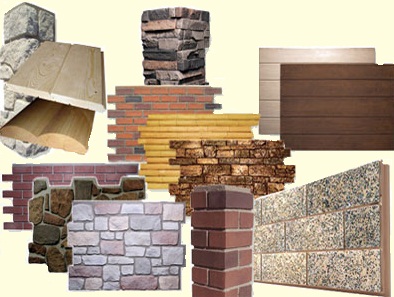 Finishing materials - very much
Finishing materials - very much All facing materials, which are presented in the modern market, have their own unique characteristics and features. When choosing materials for cladding, remember that they should not only decorate the front of the house, but also reliably cover it from all kinds of atmospheric influences, which is especially important for regions with a predominance of sharply continental climate or in general extreme temperatures such as the Far North.
The qualitative material for decoration must have the following set of characteristics:
- structural strength;
- conformity to the overall design of the structure;
- the ability to absorb moisture exclusively in the surface layer;
- maintainability;
- high performance properties.
Characteristics, pros and cons of materials
Brick
Brick lining is used today rather often. It is the facade made of bricks that people associate with reliability, durability and full protection from the surrounding atmospheric influences. Simplicity of furnish by the given stone allows to execute all stages of technology without attraction of the professional help.
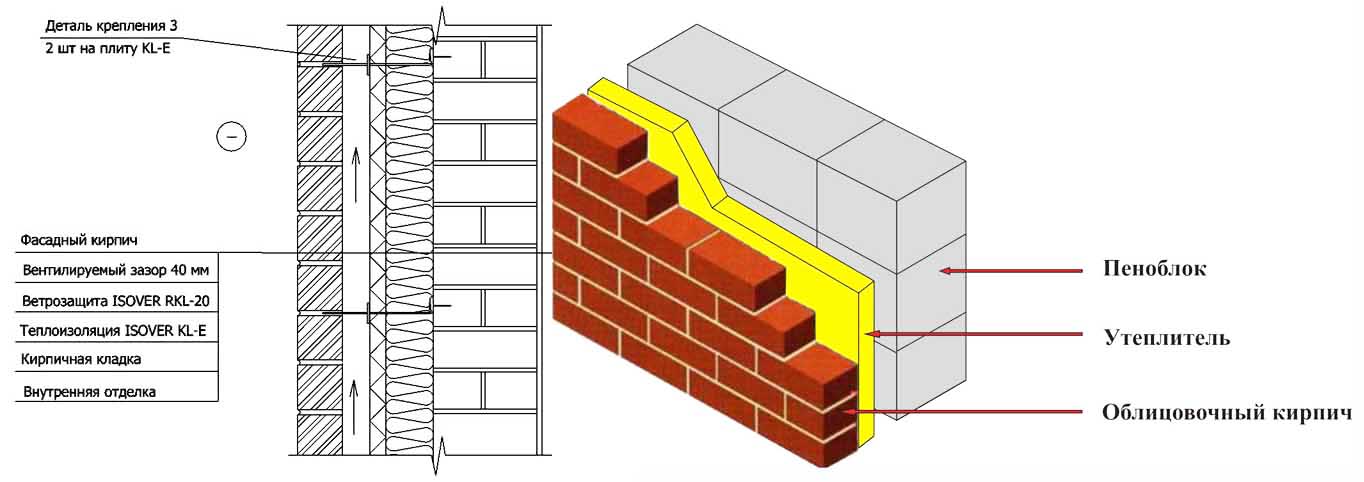
Facing the house with a brick is only possible if the load-bearing structures and the foundation of the house can withstand the specific weight of the material. Performing special works to strengthen the foundation will require you to significant financial costs. It is better not to use bricks for restoration work.
The brick should be chosen with a small amount of sand, otherwise it will dry up and crumble in the sun.
Brick, as a facing stone, has the following important advantages:
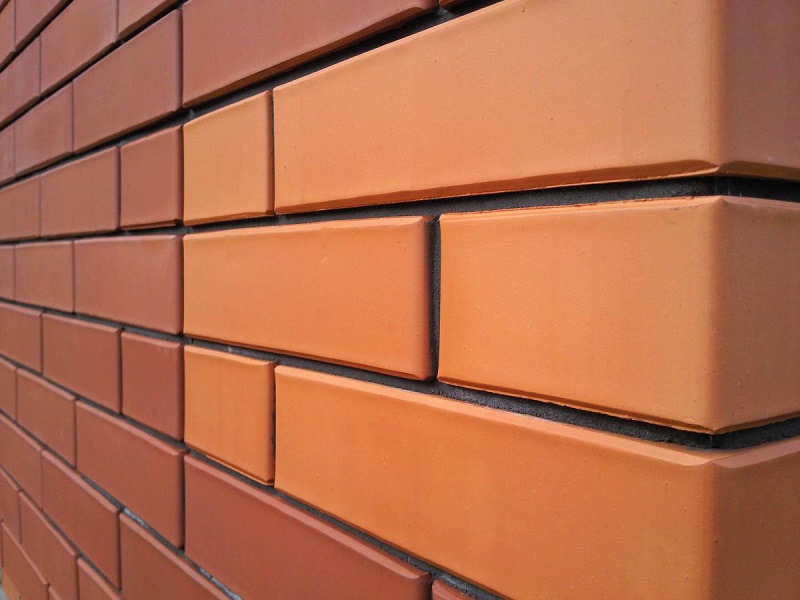 For facing the facade, it is better to choose a brick with a minimum sand content
For facing the facade, it is better to choose a brick with a minimum sand content - After finishing the exterior walls, the building will be completely isolated from moisture and wind. Facing brick passes moisture only in one direction: outward from the walls of the building;
- Ceramics of construction purpose, which is the basis of the material, is not exposed to chemically aggressive substances;
- Facing the facade of the house with brick will make the walls fireproof, resistant to significant shock and mechanical stress;
- This is one of the most environmentally friendly and safe residents of facing materials.
Even such a universal material for decoration has drawbacks. These include the considerable weight of the brick and the need for horizontal waterproofing of the foundation before the cladding.
A rock
The decoration of facades with a stone can turn your home into a real architectural and design masterpiece. Which is better - decorative or natural?
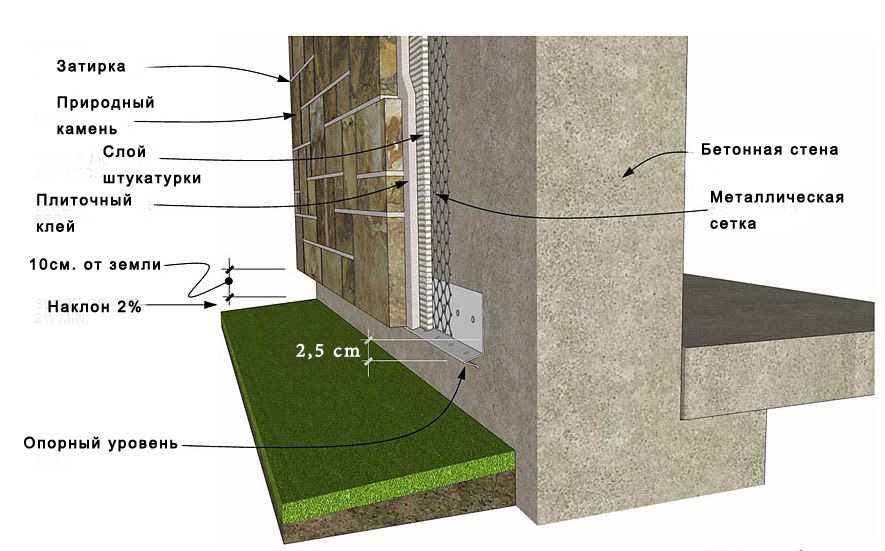 The device of the facade finished with a natural stone
The device of the facade finished with a natural stone It all depends on your financial capabilities. Natural stone is an inexpensive way of facing. But the imitating structure of the cladding is more accessible and easy to use. Facing with ceramic granite has similar features.
Stone for the facade has a number of undeniable advantages:
- Aesthetic beauty. No material compares to the external appeal and variety of textures with a natural stone;
- If you decide to use panels for the facade of artificial stone, you will receive a decorative coating that has reliability, strength, low weight, moisture resistance and excellent insulation properties;
- The operational term of the stone is unlimited;
- The stone is resistant to the action of almost all corrosive media.
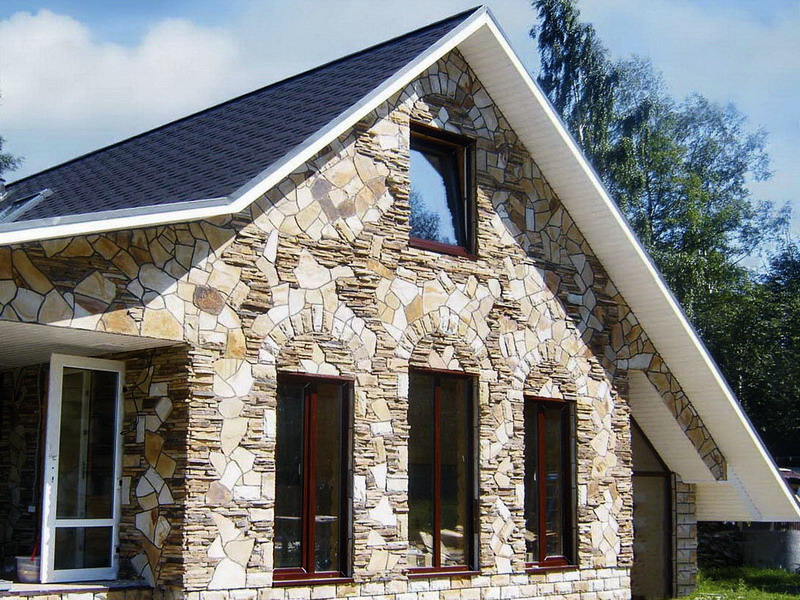 Houses, lined with stone, really look beautiful
Houses, lined with stone, really look beautiful Stone for the facade has some features that are considered to be significant flaws. They include a significant specific weight of the material. Not every facade and foundation can withstand it. Builders also note the high cost of the product.
Stone decoration has increased labor intensity. Perform it qualitatively only a professional builder who has all the necessary skills, has a set of special equipment and tools.
Clinker tiles
Clinker tiles for facades are considered to be quite popular facing products. The owners of private houses choose it because it has a whole list of positive characteristics:

Clinker tiles for the facade have practically no drawbacks. The exception is the fact that for its laying you better invite a professional builder.
Socket siding
Ground siding is often confused with a natural stone for decoration. But it is made of polymer compositions. In the plates there are holes for fastening and locks-latches, which fasten the elements together.
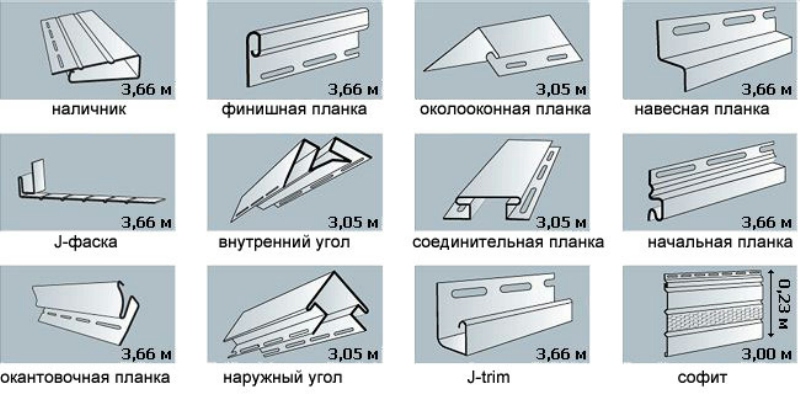 Types of panels and profiles of socle sading
Types of panels and profiles of socle sading Advantages of siding are:
- A wide range of textures and colors;
- High degree of resistance to frost, temperature drop and all kinds of precipitation;
- Installation will provide heat insulation properties;
- Facing materials in the form of vinyl panels are installed not only on residential buildings, but also on shops, office buildings.
Wooden panels
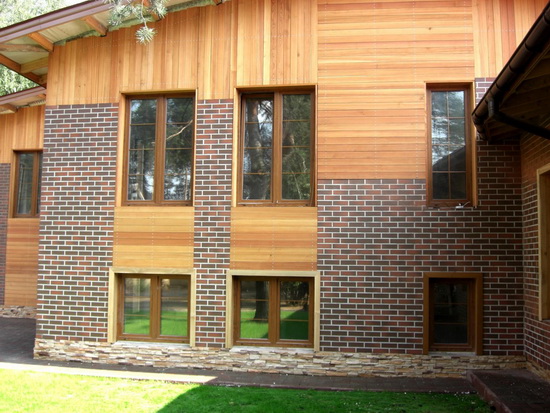 Wood trimming is a complex process
Wood trimming is a complex process The use of wood for decorative purposes in construction has always been relevant. If we are talking about the design of facade areas, then for this purpose, by pressing wood fibers, panels are made.
Such products can not be distinguished from solid wood, and their unique properties give the decorative facade coating an excellent appearance, strength, increased thermal insulation characteristics.
In a house where the facade is lined with wooden panels, there must necessarily be a high roof and a branched gutter system: otherwise the tree will simply decay.
Almost every person can install the panels. The obvious drawback of the wood fiber product is its flammability and its ability to swell with regular contact with moisture.
Vinyl panels
Vinyl panels for decorating the front of the building are made of PVC-base, which adds all kinds of stabilizers, dyes. The latter give the material strength and durability. The product is attached to the facade of the house using galvanized self-tapping screws or aluminum nails.
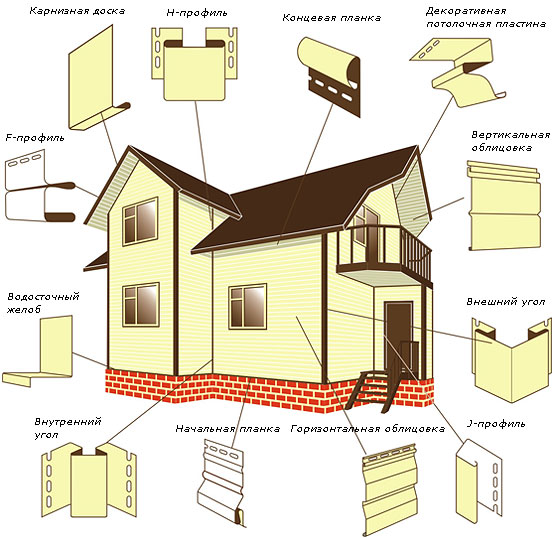 Scheme of facade finishing using vinyl siding
Scheme of facade finishing using vinyl siding Vinyl panels for finishing have the following advantages, in comparison with other materials (brick, stone):
- Ease of installation. Vinyl decorative elements are attached to each other overlap. They are easy to measure and cut into the right parts;
- Composite composition of panels is not exposed to corrosion, reliably protects the building from moisture;
- Long service life;
- Fire safety.
The most obvious shortcoming of vinyl facing panels is fragility at low temperatures. In the cold, it is better not to mount the material.
Plaster
What material is better to use for decorating the front of buildings? Compositions for plastering are considered the most versatile option. The applied plaster layer only in this case will be high-quality and durable, if preliminary to carry out thorough preparation of surfaces. Components of the formulations reliably close the walls from moisture, wind and sunlight.
 Plaster - one of the cheapest finishing materials
Plaster - one of the cheapest finishing materials The plaster has a porous structure that excludes moisture condensation in the walls and fungus formation. The plaster composition includes the most high-quality and natural components, which increase the service life of the coating to 30 years (refreshing is recommended every 6 years).
What shade of the front of the house you want to get? A rich color palette of mixtures for plastering will allow each client to find the desired. The disadvantage of plaster is that it creates a thin layer that does not increase the thermal properties.
Video
You can see a short video about what nuances should be considered when decorating the facade of the house with the help of a brick.
What should be the finishing of the facade of the house, than to finish the facade of the house, to make a beautiful and comfortable, and most importantly, environmentally friendly housing for the family?
Look at the outskirts of cities and country villages. Each code builds a mass of new houses, people enter their homes, people are gradually moving from the center to the city, to suburban homes. Certainly, beautiful facades are some kind of business cards of owners of these houses.
Good finishing of the facade of the house is not only, and not so much the decor in its pure form. In this operation there is also a practical component. Therefore, even during the design, the owner of the house and the designer should consider the compatibility of all materials used and the options for finishing the facade of the house so that the construction of the dwelling harmonizes not only with the external appearance, but also with the warming itself.
Also, the beauty of the exterior walls of your housing should be harmoniously combined with the backyard and the landscape around the entire house complex as a whole.
What are the options for finishing the facade of the house?
The construction market now is like a kaleidoscope, it is an unusually rich choice of all kinds of materials aimed at helping private homeowners, and a variety of technologies, according to the rules and technologies of which the facade decoration of houses is carried out.
Right now, several main directions have been identified, which allow us to decorate the facade of the house, so it can be insulated.
These are such ways of finishing the facade of the house, like:
- finishing with natural stone;
- decorative facade plaster;
- facing brick;
- porcelain tiles and clinker tiles;
- vinyl and wooden siding;
- all kinds of front cassettes;
- universal sandwich panels or SIP;
- wet facade.
Thanks to such a variety of possible ways to make decorative works on the outer walls of our dwellings, beautiful facades appear in every village, in every micro district every day.
Decorative ways of finishing facades - possible options
You can make a building beautiful in various ways. Consider how to trim the facade of the house, which can be used ways of finishing the facades.
Decorative facade plaster
It can be applying special stucco paints on the wall of the house or applying a thermal insulation system using paints. One of the most common and old ways of warming and decorating the outer walls is the finishing of the facade of the house with plaster.
Modern high-tech dry plastering mixtures make it possible to create textured surfaces with the prospect of their coloring.
Plaster for its main purpose is the material for leveling the surface of the walls. In modern construction, all kinds of mixtures are used for this: a solution of cement and sand, a gypsum mixture, and a solution based on lime.
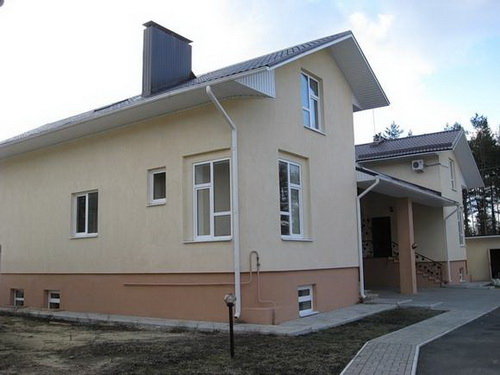
Carrying out the plastering of walls is a difficult and extremely time-consuming task. Therefore, in order to further result was ideal, mixtures are used that are similar in properties and composition.
All variants of decorating the exterior walls of residential buildings
Facing bricks
The exterior walls of the residential building can also be decorated using a facial brick. This material is the most environmentally friendly building material, because the brick is made of clay - an organic material in which there are no synthetic additives.
Facial brick does not burn, it breathes well, although it has rather mediocre heat-saving properties.
For the production of facing bricks, the method of extremely strong compression of cement mixture and limestone-shell rock is used, which makes it possible to obtain a homogeneous structure and good mechanical strength properties.
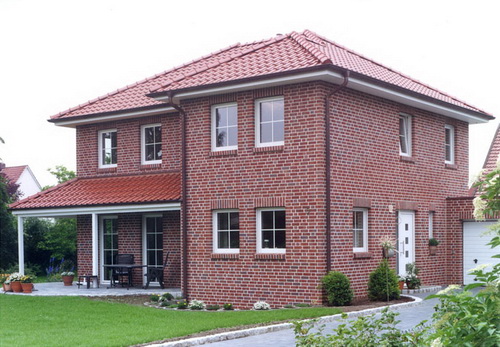
Such a brick must be kept from the ground level at 70 cm and above, plus it is necessary to waterproof the foundation so that the material does not absorb excess moisture. Certainly, professional masters will lay out decorative bricks, as usual masonry, and in the form of a mosaic, combining different color variations of the front bricks.
Using this kind of decoration of a building, one can be sure of the first-class appearance of a private house. In addition, the thermal insulation properties of the brick contribute to the saving of thermal energy in the building.
Facade cassettes
Finishing the facade of the house with façade cassettes is another technologically perfect method of protecting and decorating external walls. You can be completely sure that the building will not only be beautiful outside, but also keep the walls dry, without moldy fungus at the corners and on the north side of the building, because this material is an excellent ventilated decor.
Cassette facades are practical in use and serve for a long time. For the installation of cassettes a lot of time is not required, and care is not very time-consuming - this is a good answer to the question, than to finish the facade of the house quickly and efficiently.
Manufactured such cassettes of galvanized steel, which has a polymer coating, through which this material has a rich color spectrum, which facilitates the selection of cassettes to the taste and color preferences of the building and the area around it.
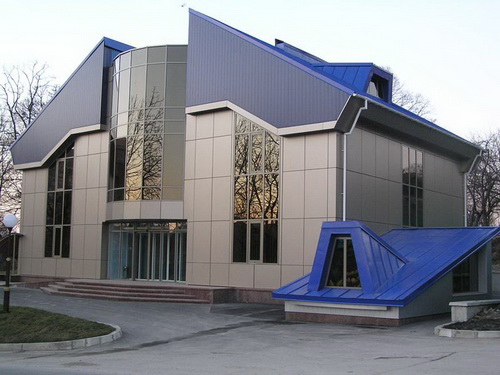
Suspended cassette facades are fixed in the same way as ceramic granite facing materials.
Finishing with ceramic granite
These are fairly durable and unusually easy to use facades. Although they themselves are quite heavy by weight. This kind of facade houses, as usual, its pluses and minuses. Read on our website some publications on ceramic granite materials.
Such material belongs to the group of ventilated systems. The construction of their four main parts consists. The first part is a load-bearing frame, which is fixed on the outer surface of the building wall in such a way that an air cushion is created between the facade and the porcelain stoneware.

On a skeleton a lath on which a layer of a heater and a membrane for a waterproofing are hung. Ceramic granite is installed in the last place.
Siding
This decoration is the simplest and cheapest. A variety of colors and textures make it possible to realize incredible, bright, most creative ideas. Such decorative material not only perfectly protects from bad weather, but also perfectly adorns the external appearance of the building.
With the help of siding, vinyl or steel, bright and beautiful facades of houses are produced in the shortest possible time.
The most popular among facing types of siding are vinyl materials. On external indicators, such a siding is similar to a board for facade cladding, but it will last much longer and preserve the appearance of the building.
It does not get dirty, and it's easy to clean it. Excellent finishing will look like siding balconies, and the main advantage is its budget side.

You can even mount this decorative building material yourself. To do this, you only need to first fix the wooden crate, and then, using the guides and all kinds of components, additional elements can be mounted on the facade of the panel.
Facing with stone
Artificial or wild stone is one of the most durable materials, which is an unusually attractive decor of the facade of the house. You can completely lining a building with a stone, or only partially.
This is quite a laborious and very expensive work. Such varieties of facades can be trusted only by qualified bricklayers, who have not only theoretical knowledge, but also practical experience with stone.
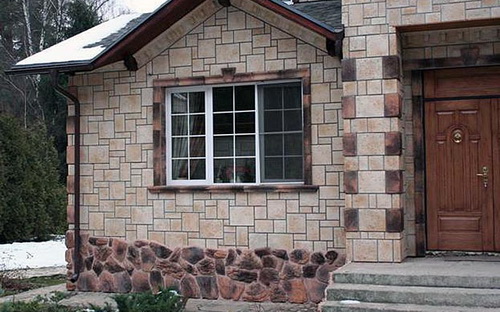
The quality of the work performed will depend on the aesthetic side and durability of this coating. If the work was done poorly, then after a while there may be flaking of the cladding, which will cause a partial collapse of the erected structure with further corrosion on the walls and rotting traces.
Sandwich panels / SIP panels
The sandwich panels have a three-layer structure that gives the residential building an extravagant presentable appearance, but also has excellent thermal insulation. They can, how to decorate the facade of the house, and warm it - two in one.
To produce such material, two sheets of hard metal are used, which are connected with a heater. For the connection, the hot pressing technique is used, so that the panels have excellent strength and long service life.

Outside the panels can be smooth, profiled, and also decorated, because of what you can make the appearance of the house simply uniquely beautiful. The installation of this material is extremely fast and easy, and there is no unnecessary burden on the foundation.
How to decorate the facade of a house using a wet method
Of course, it is worth mentioning about the wet facade, which is one of the most attractive and effective ways of warming the exterior parts of the premises. In addition, with the question of how to finish the front of the house, the wet method is very economical in manufacturing and installation.
The technology of decorating and facade insulation has been named for this reason because water is used for the work, which acts as a solvent for the materials used.
Of course, the main function of this technology is the insulation of the facade, but there are great opportunities for decorating the house, because the materials used for the final layer have a rich color scheme.
In this direction leading brands such as Ceresit constantly conduct targeted research work, releasing more and more textures and types, as every first homeowner desires to beautifully decorate the facade of the house.

To date, there are developments of all new paint solutions, with which you can create an unusually interesting texture, for example, a wet facade with imitation of brick, masonry or stone masonry.
The structure of this decorative facade insulation system is divided into 4 basic layers:
- The insulation is mounted to the wall using dowels and special mixtures on an adhesive basis.
- The insulation for the wet facade is directly the second layer. For this, mainly use polystyrene foam or mineral wool.
- Creates a reinforced layer to level the bearing surfaces and securely fix the heater. To this end, special plaster is applied to mineral wool or expanded polystyrene, and then a strong glass mesh, designed for reinforcing the plaster.
- The finishing layer is a protective decorative plaster that has a silicone, acrylic or mineral base. Based on the chosen design of the facade of the building, the plaster is painted in the required color, for this use facade paints.
Using this technology, it is necessary to ensure that all of the above components correspond to each other. Also, this system of insulated decoration provides for the use of a special reinforced socle profile, it protects the insulation, as well as the finish plaster from all possible damages of the mechanical type. Such a profile is used at the corners of the building, performing contiguity.
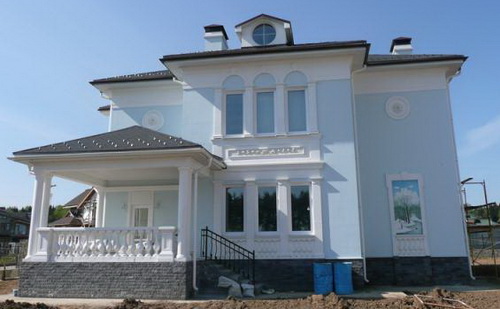
Applying this system of decoration of building facades, it is necessary to pay attention to ensuring that all materials are necessarily elements of a single system, that is, they should have similar physical characteristics, that is, frost resistance, vapor permeability, thermal expansion, and moisture absorption. More often than not, in order to adhere to this rule, such materials are already sold in building stores by ready-made systems. All components to perform such decoration of the facade must have a certificate of conformity.
This system has its pros and cons. The advantages of such a system include:
- Quite democratic value of this system. If you apply polystyrene for insulation, then the price will vary in the range of $ 20-25 per square meter, and if you use mineral wool for installation, then the price will increase to 35-40 dollars per square.
- Applying from the outside, this technology allows owners of houses to save space inside the building. In addition to this advantage, the heater is light enough, because it is applied to walls very often without additional work aimed at strengthening the structure and the fundamental part of the building.
- One of the main advantages of using such a building decoration technology are the heat-insulating and soundproofing qualities of the wet facade. With this facade, you can achieve not only a beautiful appearance of the house, but also significantly save on heating.
- The richest range of colors and properties of finishing plasters definitely improve the appearance of the house.
- Such facades have a very important advantage in practical terms - the facade repair work can be repeated and the outer layer updated.
- In terms of operation, these insulating decorative systems are very long - 25-35 years.
Of course, like any system, such a system has drawbacks.
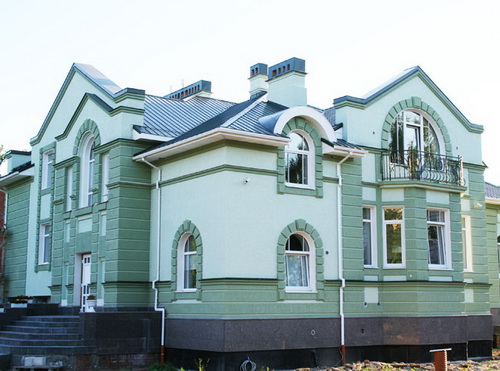
What can be attributed to the shortcomings of the system of warming and finishing the walls of the house on a wet method?
- For example, at an air temperature below 5 degrees Celsius, the finishing of the facade of the house should no longer be carried out. It is also extremely undesirable to work with the material at high humidity and the presence of precipitation in the street, because the layers of the entire system will not dry out evenly.
- If there is a bright sun in the street and there is not a cloud, then during the installation of the insulation facade system, direct sunlight will cause the drying of those solutions that are used to install the facades.
- Also, when installing such a beautiful decorative layer, it will be necessary to protect the materials from wind and dirt, dust and sand, because the external characteristics of this system will be visually reduced.
Despite these shortcomings in this decorative facade insulation system, this system is able to give any of the buildings an individuality, significantly increase the operational time and create the most comfortable living conditions in such a house.
-
Houses made of natural timber were considered a huge asset, they demonstrated the importance and consistency of their owners. Millennia passed, and wooden houses are more popular than ever. Dream of own estate ... -
Olga Dvorchuk, Kineshma: Good afternoon, dear experts. We build a house without a project, we want to do with small forces. But we would like to build it beautiful. How to make ... -
Any building requires quality finishing both outside and inside. The facade of the building in this sense is a place that requires very much attention. The facade of the building is ... -
The most common decoration of the facade of the house with plaster is very rarely used in modern multi-storey construction. At the same time, there are many efficient and economical owners who ... -
In this material we will see how to make a porch made of polycarbonate. Photo to the wooden house will show some features that distinguish the arrangement of the porch for houses from wood ....
All materials for the construction of walls: brick, concrete, stone to different degrees absorb water. In winter, ice crystals formed destroy the material from within. The house becomes cold, damp and black mold spots appear. To preserve the microclimate of housing and to protect the walls from destruction, the facade of the house is faced. Which material is best suited, is determined in each case by the owner of the house and its capabilities.
To preserve the microclimate of housing and protect the walls from destruction, the facade of the house
Wooden facades are unique and always in the brand
The tree is the warmest material with a unique pattern of lines. Each breed has its own special shade, changing under the influence of the sun and rain. Modern designers use as an facing material an artificially aged tree covered with matte varnish. It effectively looks on the background of glossy surfaces of plastic and metal, shiny glass.
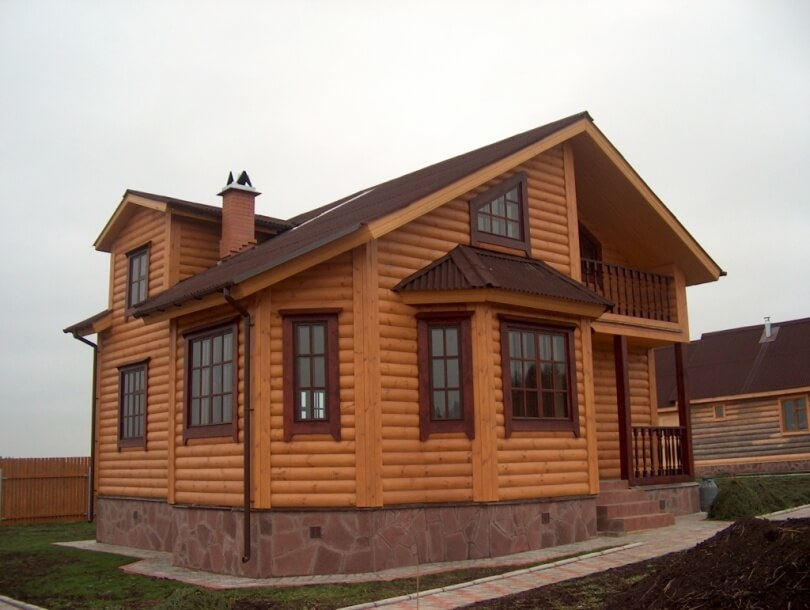
Finishing facades block house
Manufacturers offer several types of facade cladding with natural wood:
- Block House - round log;
- panels from racks - repeat the planed and glued bar;
- lining;
- ship board;
- planken;
- panels of boards and thin wooden plates;
- massive board.
The tree keeps warm and allows the walls to breathe. Due to high vapor permeability, moisture is removed from the room outside. Facing materials from wood create a healthy microclimate. The magnificent material turns a standard brick house into a luxurious tower.
Boards and panels made of natural wood are attached to the profile. Planken and a massive board are installed with a gap for expansion and ventilation. Lining and shipboard are lapped. The others are joined together by grooves.
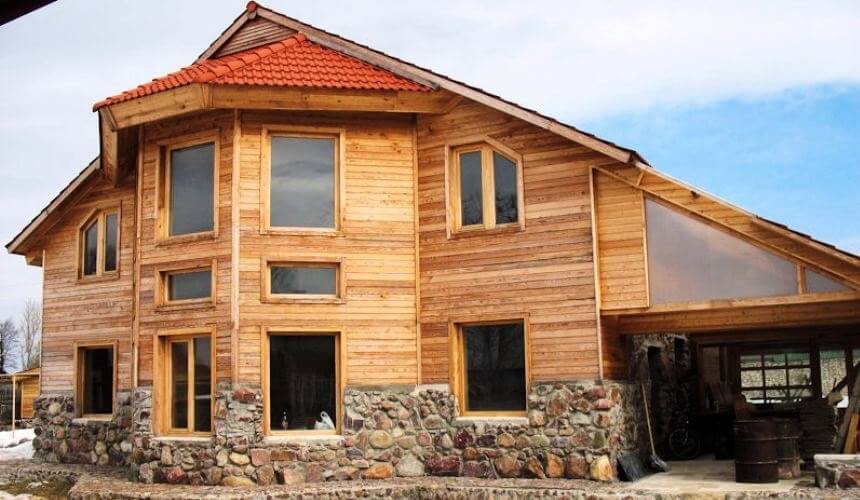
Finishing the facade lining
Shavings and sawdust with a composite is a worthy substitute for expensive material
Natural wood is an expensive material that requires regular maintenance. The wood-polymer composite and other finishing materials made of compressed sawdust and synthetic fillers have technical characteristics slightly worse. But the price is much lower. Facing products for facades completely repeat the shape and pattern of natural. The coating reliably protects them from moisture and burning out in the sun. The facade of the house looks natural. Only coming close to you can see what material is actually used.
The main technical characteristics of facing facade materials from wood and composite with shavings.
| Material | hygroscopicity | warping from water,% | life without coating, years | flammability |
| tree | absorbs water | 12 | 25 | burns |
| WPC | does not absorb water | 1 | 50 | does not burn |
Thermal conductivity and vapor permeability differ little. Wood requires constant care, covering with protective means from insects and moisture. All the necessary components are added to the KDP during production.

Facade of the KDP
Facade made of natural stone - durable luxury
Natural facing stone is durable. It gives the building a luxurious view. It is enough to trim the plinth with marble, diorite or rocks of dark tones, choosing material of large sizes, and the house becomes massive.
The facade looks noble from soft rocks:
- dolomite;
- sandstone;
- limestone;
- shell rock.
They have shades of pastel and warm tones of beige, yellow, brown and cream. Depending on the desire, the usual structure turns into an ancient castle, fortress or fairy house of a good king. The building acquires an individuality. It is impossible to create two identical facades using a natural facing stone.
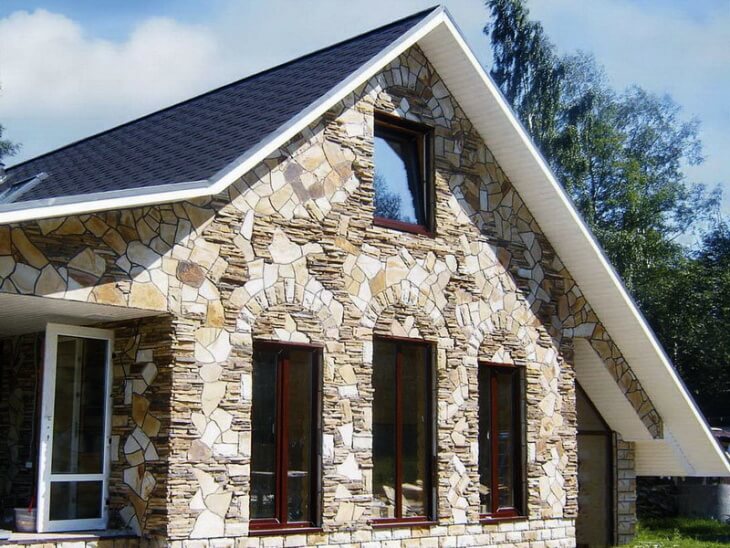
Facade made of natural stone
Finishing requires maintenance. Once every 3 to 5 years, it is desirable to cover the facade of the house with a protective mixture. The stone absorbs water within 3%. However, the solution by which it is connected is hygroscopic and breaks down from moisture. Work on the facade should be carried out by a specialist.
Facing the facade with natural stone is expensive. It is for people with wealth and ambitions. This material speaks about the good taste of the owner and his uniqueness.
The disadvantages of finishing the walls of the house with natural stone include a lot of weight. If a standard foundation was laid during the construction of the building, then it must be strengthened. Adhesives and finishing materials need to buy special, ready-made, containing additives.
Artificial stone for finishing the facade - a budget option for creating a masterpiece
The most common artificial stone used for construction and finishing is brick.
For cladding materials are made of red clay for different technologies:
- clinker panels with insulation and in the form of plates;
- terracotta slabs;
- facing brick.
Materials differ in manufacturing technology. The clinker is pressed and fired at a temperature of more than 1000 degrees. It does not leave pores and air bubbles. During sintering, a glossy hard surface is formed. The clinker repels moisture. Does not react to most acidic and alkaline chemical reagents. High abrasion resistance makes it an excellent material for the plinth.

Finishing of the facade with clinker tiles
Facing bricks and terracotta slabs absorb moisture in small amounts. The facade of the house, finished with such a material, is necessary immediately after the glue dries and covered with protective mixtures every 3 years.
Covered with materials from annealed clay, the facade of the house looks new. A large selection of colors allows you to combine and create unique options.
Polymer and vinyl filler with sand and cement in the facade panels imitate the shape, color and texture of natural stone, masonry, wood:
- porcelain tiles;
- fiber cement;
- glass fiber-reinforced concrete;
- porcelain tiles;
- vinyl panels.
They are much cheaper than natural materials. Mount them on the wall and the foundation can be hand-made. This is a budget option for creating a magnificent facade with excellent characteristics. From a distance, synthetic material from natural is impossible.

Facade made of facing brick
Budget plaster and combinations with wood and stone
Classic facade decoration for many decades, it's plaster. It is applied to the wet facade in several layers. Modern finishing materials in the form of paints and decorative putties have become reliable wall protectors against moisture. A wide range of colors and textures allows you to create individual facades for every taste.
The plaster is perfectly combined with various materials. The stone base and the decoration of the corners give the house a solid foundation. Finishing the windows highlights them and does more. Plastered and painted walls emphasize lightness. Use and combinations with wooden elements. The number of options is infinite.
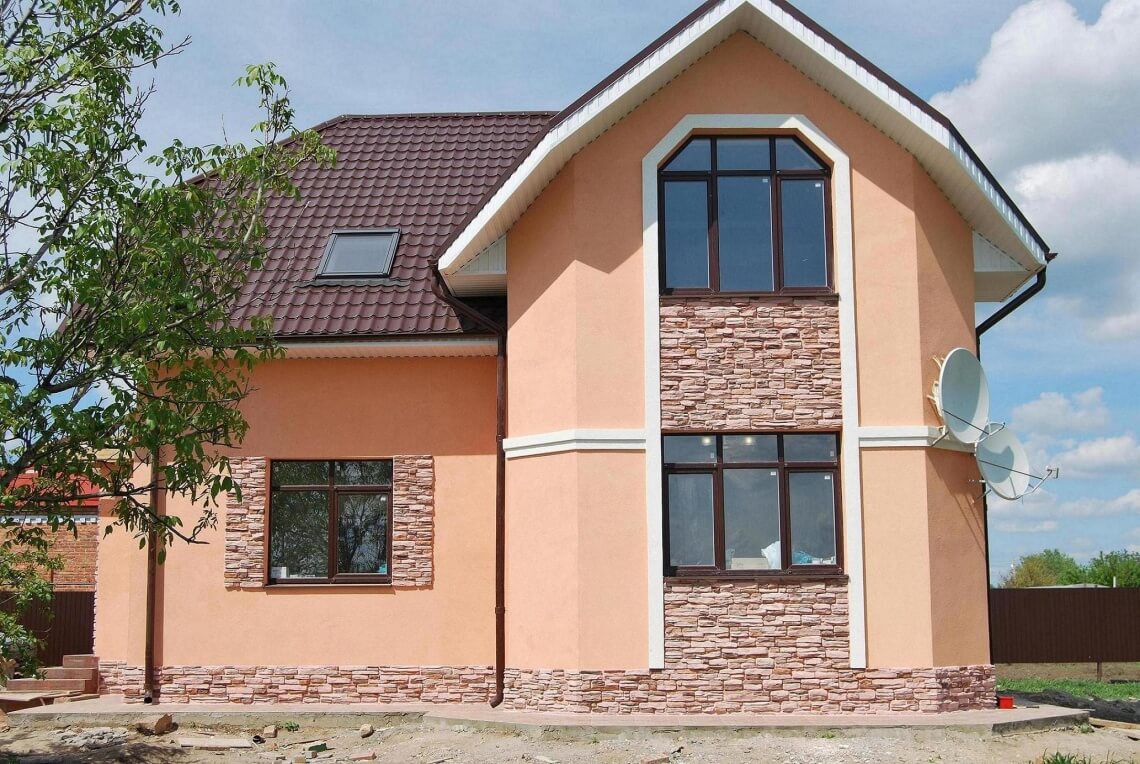
The plaster is perfectly combined with various materials
Siding for three days with their own hands
For those who want to protect the facade of the house and do everything at the lowest cost, you can mount the siding:
- vinyl;
- acrylic;
- metal.
Fastening on a lath with the help of self-tapping screws and interlocking into the lock allows you to quickly make the lining of the house with your own hands. The cost of siding is low. Significantly more expensive additional elements and profile. Therefore, you need to measure everything and calculate the expense, so as not to buy excess.
![]()
Hello, dear reader!
I'll tell you what to improve the facade of the house, how to choose a material without much damage to the wallet, about the pros and cons of popular types of finishes.
We will talk about affordable invoices that are not inferior in quality to expensive analogues.
The market is full of offers. One of their leaders in sales is siding. Among the variety of presented collections are more often buying panels from vinyl and wood. Panels from PVC differ strength, a small load on the frame. Styling under the natural texture provides the house with a decent look.

- resistant to atmospheric phenomena;
- have a wide range of colors;
- when properly installed, serve up to half a century.
When installing, you must take into account the linear expansion, in order to avoid deformation of the panels with temperature fluctuations.
Features of wood siding
If there is no possibility to build a frame, the facade of a wooden house should be better covered with wooden siding. The smell of wood in the house will not be felt, but 100% similarity to the original is ensured. The option is especially relevant for summer construction.
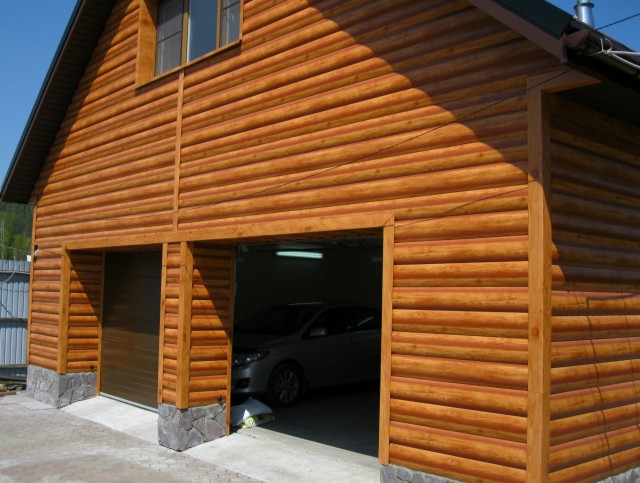
- Block house with a volumetric radial surface - a copy of round logs. The size, class depends on the diameter, the wood species. Due to the one-sided spikes and grooves, the edges densely dock with the neighboring ones.
- Styling under the bar is distinguished by a flat surface without relief, except for the line from the chamfer at the edges. Wrought walls look like real.
The structural density of wood determines the period, the quality of operation. The boards are made of pine, linden, fir. Larch is not afraid of rain or frost, but with poor protection on the surface appear cracks. Timely application of a new layer will relieve such problems.
Angarsk pine is characterized by high density, antibacterial qualities, with proper care it serves for decades. Products made from composite wood do not inspire confidence, although attractive in price. The technology is similar to the manufacture of MDF and is inferior to natural wood in terms of its main characteristics. And this:
- aesthetics;
- ecological compatibility;
- high heat - noise insulation.
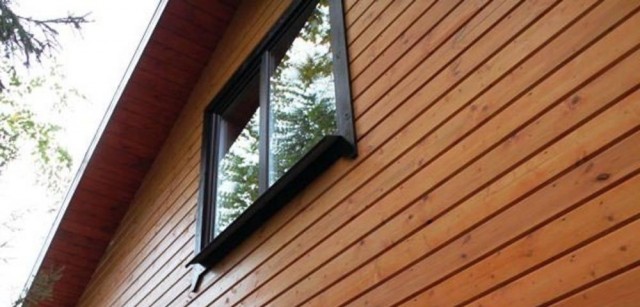
Disadvantages:
- walls need periodic staining (drying oil, stain, impregnation);
- fire dangerous;
- panels may become deformed;
- with insufficient impregnation of antiseptic spider bugs are found.
Fibroplates
It is comparatively inexpensive to decorate the facade of the house from the outside with slabs of cement and cellulose fiber. A durable and beautiful coating will last for 20 years. Eco-friendly products copy natural bases, differ:
- fire resistance;
- impact resistance;
- can withstand up to 155 cycles of freezing-thawing.
The price of the fiber cement board is slightly higher than the siding, but the aesthetics and quality are worth it.
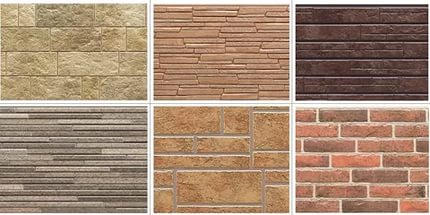
A rock
Natural stone is an expensive pleasure. In most cases, it is used to decorate the socle, which needs reliable protection from unfavorable factors. It is better to trim the facade of a private house with an artificial analog, stylized as the original. The variant is quite competitive, while:
- has high strength;
- resistance to aggression of the environment, fire;
- simple installation;
- has a decorative variety.
Thermal panels, facing brick
Substrate of foam with glued clinker tiles is practical and durable. Foam base provides heat, beautiful styling of tiles - decorativeness.
The material is not cheap, but who does not know how to trim the corners of the house on the facade, you can only buy corner sections separately. They are well combined with other textures, add decorativeness.

One of the most sought-after materials is the old reliable brick. Aesthetics with professional masonry, durability and strength people have long appreciated. The market is replete with imported and domestic products.
Ceramic, clinker, hyper-pressed brick with different textures will decorate any facade. However, finishing is expensive.
Very budgetary and uncomplicated version. Facing insulation, reinforcing mesh and plaster is relevant for creating an energy-saving focal zone. Therefore, can easily solve the problem, than to finish the facade of a brick house, a building made of aerated concrete, a foam block, particle board, wood.
Advantages of multi-layer construction:
- possibility of restoration;
- reduction of operating costs up to 40%;
- affordable prices;
- multivariance of solutions.
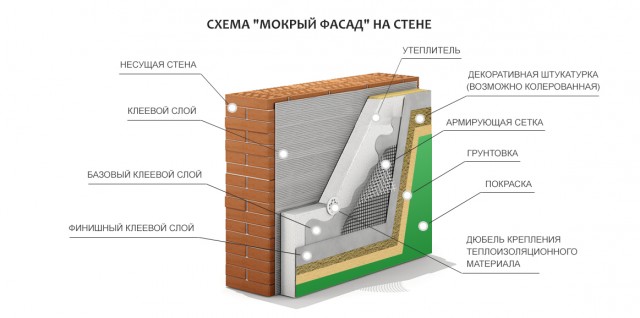
Instead of the finishing layer, it is possible to paste clinker tiles up to 20 kg / m 2. with imitation of bricks. Externally, the house will not differ from the real masonry, but the weight of the walls will save on the foundation.
In comparison with ventilated facades, "wet" is cheaper, and the lack of brackets, other fasteners will not create cold bridges, through which heat is lost.
Features of facing of the house from aerocrete blocks
The sheathing of walls erected from hydrophilic materials has its own nuances. Here we need protection from precipitation and we must not forget about the exit of steam. To make a facade of a house made of aerated concrete you can:
- Face brick, leaving vented seams in 45-50 mm. In this case, at the stage of laying the foundation, its width is corrected, so that the places get to the bricks and blocks. However, the option is not cheap.
- Tiles. It is more cost-effective, but the glue, the mesh and the work of the master cost money. In this case, the material is inferior in terms of thermal insulation and strength. And the vapor barrier from the inside needs a reliable one.
- Ventilated facades with a decor of siding, lining.
- It is better to coat the facade of the house with mineral mixtures, so that the finish coat does not interfere with the diffusion of the vapors outside, and then paint. For this purpose, the standard cement-sand mortar and film-forming compounds are not suitable.
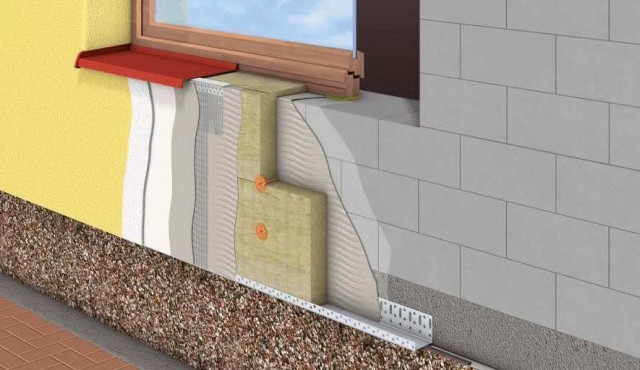
The facades, painted with vapor-permeable paint, lose appeal over time. Not durable and thin putty in 5 mm, designed to work with porous material. Cracks quickly form on the walls, requiring periodic correction. Blown walls increase heat loss.
How to make the right choice, you ask. This article is a review, in other articles of this column and we will take a closer look at various options for finishing the facades. Come in.
I hope that a short review of the materials in demand will help you to choose a little. Thank you for reading to the end. I would be grateful if you share the material in social networks, leave a comment. To have the right information at your fingertips, subscribe to updates.
